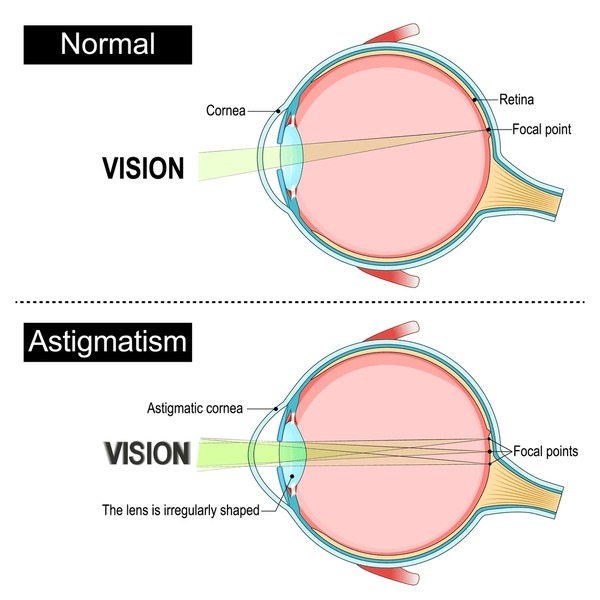Introduction
Astigmatism means an irregular shape in the cornea leading to blurry vision. Essentially, the eye is less oval and more rugby-ball-like in shape. Since clear sight is crucial for daily life, understanding eye astigmatism treatment becomes important for those affected. What are the signs? They might manifest as blurred vision, headaches, or squinting. Spotting these early enables more effective management. Recognizing symptoms may not be as easy, yet awareness is essential. By the blog’s end, you’ll know more about astigmatism and relevant solutions. Early detection can make a huge difference in managing this common vision condition.
Understanding Astigmatism
What is Astigmatism?
The eye isn’t a perfect sphere; it has a bulge, similar to a football which impacts how light focuses inside your eye. Think of it like a camera lens. Astigmatism disrupts light’s focus, resulting in blurred images. This variance separates astigmatism from other conditions like nearsightedness, where images focus in front of the retina, or farsightedness, where images focus behind it. Astigmatism affects the quality of focus, unlike these conditions. Identifying these differences empowers better understanding and management of your vision. Knowing how light fails to focus correctly with astigmatism aids in recognizing and differentiating eye conditions.
Symptoms to Watch For
Seeing blurred and distorted images is a usual sign of astigmatism. Other telltale symptoms are frequent headaches or tired eyes from straining to see. And what’s normal? Squinting often or having difficulty seeing at night can indicate an issue. But these symptoms also occur in other eye problems, so awareness of onset and pattern matter. If such symptoms frequently occur, consult an eye specialist to confirm if it’s indeed astigmatism or some other vision complication.
Diagnosing Astigmatism
Self-Assessment Methods
Though checking vision at home doesn’t replace professional advice, simple tricks like reading a book at different distances can help spot astigmatism early on. Pay attention. Do you need to squint or adjust the book often to see better? However, self-tests provide only a tentative idea, useful in prompting a visit to your specialist. Detecting astigmatism yourself has its limits, and professional advice is indispensable for reliable confirmation of any condition.
Professional Evaluation
In India, eye exams involve reading letters on a chart and using devices to measure eye focus. Such professional evaluations accurately diagnose astigmatism. They’re not invasive and carry no risks. Most optometrists or ophthalmologists offer comprehensive assessments. Remember, regular professional check-ups are best for clear understanding and possible correction of any eye problems. Getting a valid diagnosis from a professional aids in receiving precise eye astigmatism treatment tailored to one’s specific needs.
Causes and Risk Factors
Genetic Influences
Astigmatism can run in families. If parents or siblings have it, there’s a greater chance you’ll develop it too. This genetic tether makes it key to monitor vision closely, especially during childhood. Early detection can lead to better management.
Environmental Influences
Daily activities impact vision. Using electronic gadgets, like tablets and phones a lot, might worsen astigmatism. Bad habits like reading in poor lighting or poor posture when watching screens also contribute. Reducing these activities might help. Here’s how: – Take frequent breaks from screens. – Ensure adequate lighting during work. – Maintain proper distance from viewing sources.
These steps can mitigate environmental risks associated with astigmatism.
Solutions and Treatments for Astigmatism
Corrective Lenses
Many choose glasses or contact lenses to manage astigmatism. They help light focus appropriately, yielding clear vision. Glasses are easy to handle, but contact lenses offer more flexibility. Keep lenses clean to avoid infections. Here are some care tips: – Regularly change your contact lenses. – Store lenses in proper solutions. – Clean them thoroughly.
Depending on your lifestyle, one might suit better. Consult with the eye specialist regarding options that align with your daily routine for effective eye astigmatism treatment.
Refractive Surgery & Laser Treatments
For some, surgery might be an attractive option. LASIK, a popular corrective procedure in India, significantly improves vision. It’s quick, usually with rapid recovery, offering a long-term solution. Consider factors like age, health conditions, and personal risk tolerance. Evaluation by a professional determines suitability and expected outcomes. Surgical outcomes are lasting, but one must weigh potential costs and benefits before deciding if it’s the right course of action.
Choosing the Right Solution
Consultation with Eye Care Professionals
Selecting a fitting treatment needs expert advice. Seek specialists with strong reputations, as they can provide appropriate evaluation and personalized recommendations. In India, several reputed eye clinics specialize in astigmatism.
Balancing Costs and Needs
Consider the financial aspect while choosing a treatment. Compare the costs against your specific needs. Health should be priority, but financial planning ensures practicality. Some clinics even offer payment plans or financial assistance for those in need.
Conclusion
Eyes perform a highly significant role in life. Regular eye exams go a long way in maintaining vision health. If you suspect astigmatism, see a professional who can help navigate treatment options. Remember, understanding


